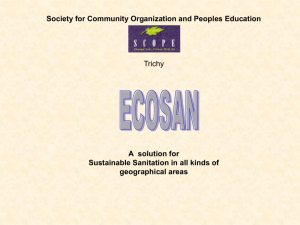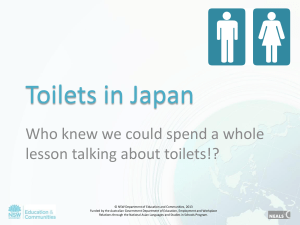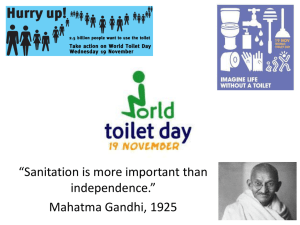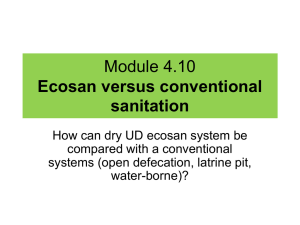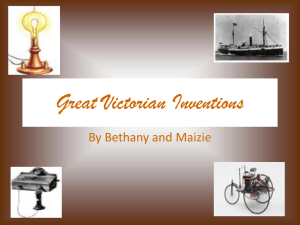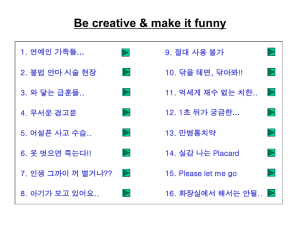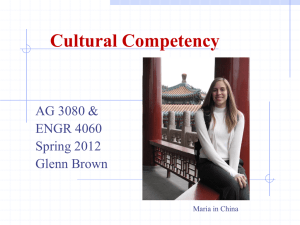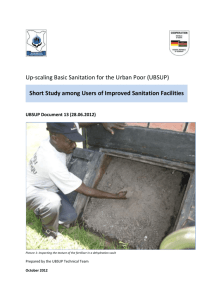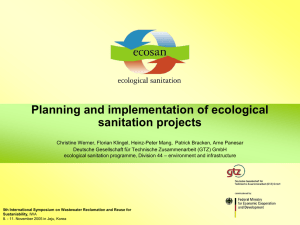5_Erdos_project_overview_Zhu_Qiang_Aug_07_
advertisement
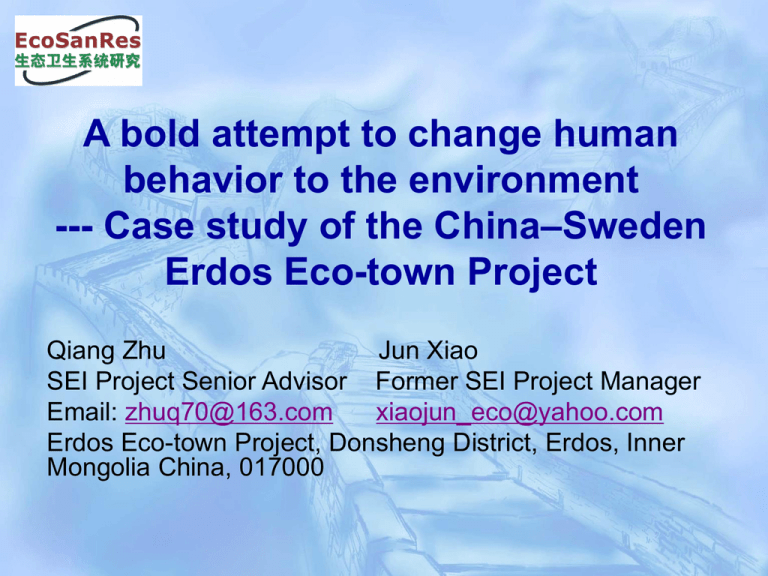
A bold attempt to change human behavior to the environment --- Case study of the China–Sweden Erdos Eco-town Project Qiang Zhu Jun Xiao SEI Project Senior Advisor Former SEI Project Manager Email: zhuq70@163.com xiaojun_eco@yahoo.com Erdos Eco-town Project, Donsheng District, Erdos, Inner Mongolia China, 017000 Background information • China – Sweden Erdos Eco-town Project (EETP) is part of the EcoSanRes Programme funded by Swedish International Development Agency (Sida) and technically supported by the Stockholm Environment Institute (SEI). • EETP aims at sanitizing and recycling all the waste from the human residence under the urban condition. • An ambitious attempt to generate the data, technologies and policies required to bring about a major change in the way urban settlements relate to the environment. Inner Mongolia Erdos Project area Yellow River Beijing Yangtze river Shanghai Tibet Project site map Guangzhou Features of Dongsheng • Population: about 400 000 • Area 2200 km2 with altitude of 1400 -1500m • Cold, dry and windy climate: yearly mean temperature 5.6oC, annual precipitation 385mm, potential evaporation 2040mm • In Erdos, locate the biggest coal and natural gas mine in the State • GDP per capita in 2003 exceeded US$2000 • Water shortage has become the bottle neck Physical features of EETP • Forty two 4-5 storey buildings equipped with non-flushed UD ecosan seating toilet; • 832 flats with about 2900 inhabitants; • GRW and urine piping system and 22 urine tanks Eco-station – – – – – – – GRW treatment plant Post-treatment pond Composting plant Composting plant Solid waste center Management building GRW experiment lab, and Agriculture experiment plots Management building Post treatment pond Solid waste center GRW treatment plant Households GRW GRW treatment Class II drainage Reclaimed water Faeces & Urine Urinal UD toilet Urine tank Compostable F bin Market recycling Composting Greening environment Water body Solid waste Agriculture production Food & clothes Boundary of neighborhood Recyclable Industrial reuse Non compostable Solid waste center Non recyclable Bury & incineration Industrial products Recycle flow Faces & urine system – Urine diversion seat toilet – Faces drop chute – Faces bin and bin cover – Ventilation system – Urine piping – Urine tank GRW system – Composed of the piping system as well as a septic-regulation tank and treatment plant – Designed capacity of 250m3/day – The “hydrolysis-acidiolysis + bio-contact oxidation” technique, a combination of anaerobic and aerobic process, is adopted for treatment of the GRW using the active sludge and microorganism filtering. – A further treatment facility with high effective filtering and adding disinfection agent is installed for enhancing the water quality to recyclable standard. Ventilation system in EETP Negative air pressure is created in the toilet room. The air is sucked by a fan from toilet room through faeces chute and vent duct flows up to the roof to prevent the odor. Technical and economical feasibility of Ecosan system in the urban setting Water consumption can be reduced by 30%. Preliminary test on the agriculture reuse of human excreta showed the corn yield can be raised by 32.9% and 67.6% with application of 7.5 t/ha of compost plus 6 t/ha of urine and 22.5 t/ha of compost plus 12 t/ha of urine, respectively. Technical and economical feasibility of Ecosan system in the urban setting Input for the ecosan-toilet is higher than the flushing one by about USD 920 for each household, 6% of the flat cost. It can be partially paid back by reducing treatment cost of GRW compared to the mix waste water and saving the cost of drainage pipe network as well as recycling the human excreta and GRW. Benefit of environment protection, human waste recycling and resources conservation in a long-term period would be much more significant than the cost spent today. Challenges and mitigation The main problems happened during operation is the odor in the toilet room complained strongly by the households. The reasons are: • Imperfectness of the system due to poor construction and installation quality of the contractor. • Improper use of the toilet by the households: the user poured too much water into the toilet for cleaning thus worsened the smell problem. • Inadequacies in design of the ecosan system also existed. Hardware mitigation -1 Toilet design has been upgraded and household can have more choices on the toilet type. – Urine tank was sealed to reduce suction of ammonia air to the toilet room. S trap is installed under urinal odor prevention device is developed by Swedish expert and installed in the urine hole of toilet to isolate the urine. – Hardware mitigation -2 – The bin cover is replaced by the sealed cabinet – Vent pipe in the basement has been re-arranged to minimize the flow resistance and to reduce risk of blockage of the pipe. – Appropriate fan has been selected to replace the inadequate one. Software mitigation Promotion of ecosan and training of the household on proper use of eco-toilet has been strengthened by frequently visiting the household and distributing brochures and posters. An operation and maintenance team has been set up for 24-hours service of the ecosan system. Result of mitigation – Air quality in the toilet room has been improved. Tests showed that the concentration of ammonia in the toilet room has been decreased by 7.8% to 78.1% in the period from October 2006 to June 2007. – Complain on the bad smell has been reduced. According to questionnaire investigations to the households, replying “no odor” increased from 33% to 51% in January and April of 2007, respectively. – However, up to now there are still complains on the odor problem. Replying “heavy odor” was about 15%. Improvement of the system is going on. Challenges to fully achieve the goals • Acceptance of the households • Motivation of the stakeholders • Technical development Households’ acceptance • Three types of families: Small portion are very satisfied; most accept the dry toilet but still hope to have the flushed one; another small part are not happy at all. Some of them have already changed the toilet into flushing one. • In addition to the inadequacies of the toilet design, important reasons of the unsatisfactory altitude is the traditional culture and bias that take the dry toilet as a retrogression to the flush one. They think to store the faeces under their toilet room is not a pleasant matter and “should” be smelly. • The promotion work is effective but it is a long term job to change people’s mind and behavior. Motivation of the stakeholders -1 Household: • Pay attention to helping them understand the meaning of eco-town. • Since the households undertake additional jobs in using the toilet, and with these they have contributed to the environment protection and resources conservation, they should be encouraged by the society. Saving flushing water does payback but is not enough. • They should enjoy incentives from government, like lower price for purchasing flat with eco-toilet Motivation of the stakeholders -2 Estate developer • In its developing stage, cost of building ecosan system in urban area will be higher than a conventional one. In EETP, it is estimated that the developer has to invest about RMB 7000 (USD 920) per flat more than the conventional. Owing to the limit of the eco-toilet technique so far, buildings in the eco-town can be built with 4-5 stories, thus increasing the land cost per flat. • Motivation of the estate developer can be kept only if they can get the about benefit with that of the conventional. For this, policies for incentives by the government are essential. Motivation of the stakeholders -3 Government • Local government would have additional payment for eco-town temporarily : favorable policies to estate developer; perhaps part of the O&M cost of the system, etc. • From long term perspective, environment and resources conservation will eventually payback. • A foreseen leader should recognize this and give favorable policies in taxation, land price, waiving of fees for estate development as well as encourage the people to accept ecosan by lowering price of eco-building. Technical development – – – – – – The basic pre-condition for social acceptance is to improve ecosan technology continuously: Diversified toilet design to meet the demand of households with different preferences, cultures, and bias Affordable by the household and well functional: easier to operate, able to be cleaned with less water and to be more robust in use Improvement of smell by nice ventilation design, installation and operation and odor separation To find economic and efficient solution for GRW treatment in the urban area where the land cost is high Cost-effective solution for on-site composting without polluting environment Study on the environment impact assessment, economic evaluation of the eco-town Points of view Eco-town is a complete new thing to China and to the world. In its beginning stage of development, it might not be able to compete economically with the conventional solution owing to: – Technique is not mature so far, many improvement would be made; – Undeveloped market mechanism for ecosan products because of small number of producers; – Small scale requirement of the product; – Recycled nutrients and reclaimed water has not got fare price and recycling channel has not been going through. Points of view At the present stage, Ecosan like other newly developing sustainable technique is a redistribution of benefit and cost among different stakeholders and between present and future generations. It is essential for the government leaders to issue wise policies to regulate the redistribution so as to promote this new rising force. Points of view Ecosan in China is somewhat more challenged owing to much denser population, costly land in urban area. R&D and a appropriate procedure for promoting ecosan is more important. It seems better firstly have smaller scale project for R&D and demo purpose with the participation of volunteer households. Different technologies can be tested for different preferences and customs. The successful results of the demo building can be a good base for further application in larger scale.
